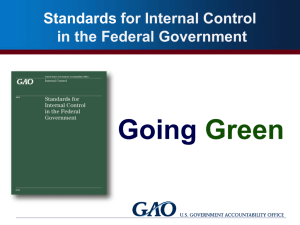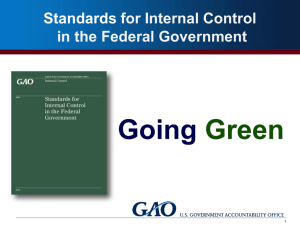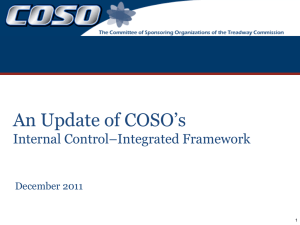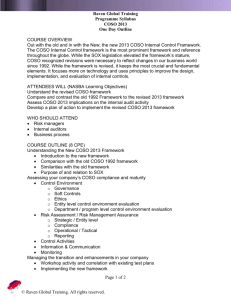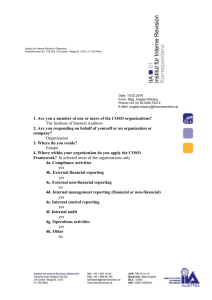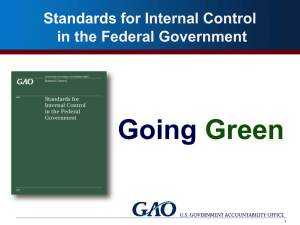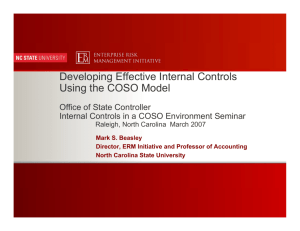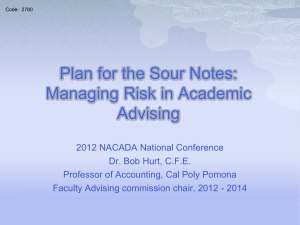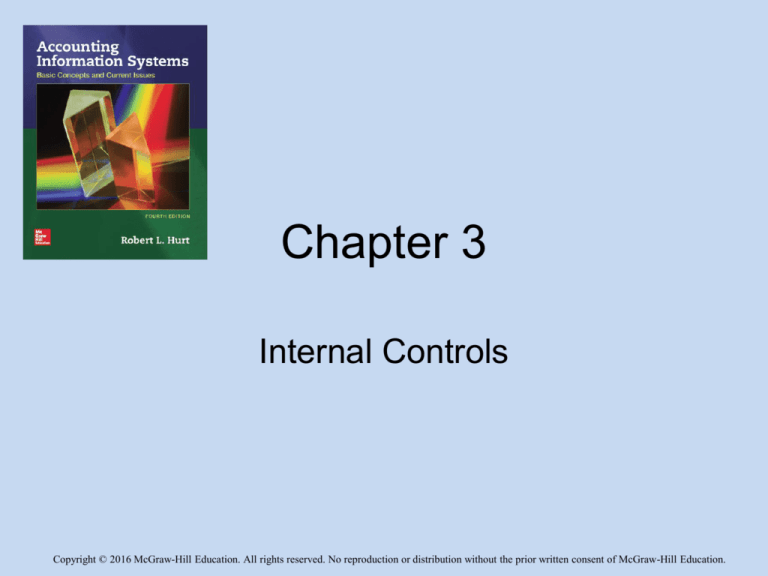
Chapter 3
Internal Controls
Copyright © 2016 McGraw-Hill Education. All rights reserved. No reproduction or distribution without the prior written consent of McGraw-Hill Education.
Outline
• Learning objectives
• Risk exposures
• Internal control
definition
• Risk / control matrix
• Internal control
purposes
• COSO framework
3-2
Learning objectives
1. Define internal control and explain its
importance in the accounting information
system.
2. Explain the basic purposes of internal
control and its relationship to risk.
3. Describe and give examples of various
kinds of risk exposures.
3-3
Learning objectives
4. Prepare a simple risk/control matrix.
5. Summarize and explain the importance of
COSO’s 2013 “Internal Control—
Integrated Framework.”
6. Critique existing internal control systems
and design effective internal controls.
3-4
Internal control definition
A process, effected by an entity’s board of
directors, management and other personnel,
designed to provide reasonable assurance
regarding the achievement of objectives
relating to operations, reporting and
compliance.
From COSO’s 2013
Internal Control
Integrated Framework
3-5
Internal control definition
• Key elements of the definition
– Process. Internal control is not a list of rules
or “boxes to check off.”
– Effected by [various groups]. Internal
control is the responsibility of the whole
organization—not just the accounting
function.
3-6
Internal control definition
• Key elements of the definition
– Reasonable assurance. No internal control
ever provides absolute assurance. The
benefits of a control must outweigh its costs.
– Objectives relating to:
• Operations: business processes, such as the
sales / collection process.
• Reporting: financial, tax, internal.
• Compliance: applicable laws & regulations, such
as SOX and the Foreign Corrupt Practices Act.
3-7
Internal control purposes
• Safeguard assets, such as by depositing
cash daily in the bank.
• Ensure reliable financial reporting, such
as through financial statement audits.
3-8
Internal control purposes
• Promote operating efficiency, such as with
a procedures manual.
• Encourage compliance with management
directives, such as by appropriate training &
performance reviews.
3-9
Risk exposures
• To develop strong internal
controls that achieve the
• By identifying their risk
exposures, they can
develop and implement
four purposes, many
organizations think in terms
of risk.
internal controls to address
them.
• “Address” can refer to
preventive, detective or
Identify risk
exposures.
corrective controls.
Develop
internal
controls.
3-10
Risk exposures
• Brown’s taxonomy
• Four major categories
– Financial
provides one good
– Operational
organizing structure
– Strategic
for talking about risk.
– Hazard
3-11
Risk exposures
• Financial risk
• Strategic risk
– Market risk
– Legal & regulatory risk
– Credit risk
– Business strategy risk
– Liquidity risk
• Operational risk
– Systems risk
• Hazard risk
Directors’ & officers’
liability risk
– Human error risk
3-12
Risk / control matrix
Risk
Risk category
(Brown)
Internal control
Internal control
purpose
Comments*
Theft of inventory
liquidity risk
separation of duties
preventive
acquisition /
payment process
liquidity risk
establish proper
storage conditions
preventive
conversion
process
human error risk
internal audit of
shareholder
database
detective
financing process
systems risk
data encryption and
firewalls
preventive
human resource
process
credit risk
established
procedures for
granting credit,
including a separate
credit department
preventive
sales / collection
process
Spoiled raw
materials
Dividends paid to
the wrong
shareholders
Disclosure of the
database of
employees' Social
Security numbers
Granting credit
inappropriately
Table 3.2
3-13
COSO framework
• Committee of Sponsoring Organizations
of the Treadway Commission on
Fraudulent Financial Reporting
• www.coso.org
• Original internal control framework: 1995
• Updated framework: 2013
3-14
COSO framework
• Five components, all necessary for strong
internal control
– Control environment
– Risk assessment
– Control activities
– Information and communication
– Monitoring
3-15
COSO framework
• Control environment
– Organization’s overall attitude about internal
control
– Must be established at the top of the
organization (CEO, CFO)
– Often called the “tone at the top” or “tone
from the top”
3-16
COSO framework
• Risk assessment
– Organization’s risk
exposures
– Tools like the Brown
framework can help
ensure “all the bases
are covered”
Identify risk
exposures.
Develop
internal
controls.
• Control activities
– Specific internal
controls to address
risks
– Preventive / detective /
corrective
– A control may address
multiple risks; a single
risk may involve
multiple controls.
3-17
COSO framework
• Information and communication
– How the entire internal control plan is
disseminated throughout the organization
– This framework element relates to the plan in
its totality.
• Monitoring
– Ensuring the plan’s ongoing effectiveness
– May be entrusted to the internal audit
department
3-18
COSO framework example
Information &
communication: Required
annual training on internal
control for all employees.
Control environment:
Open door policy from
CEO / CFO regarding
internal control
Control activities:
Strong network security.
Data encryption.
Firewalls. Continuous
monitoring.
Risk assessment:
Wireless network
may be
compromised.
Monitoring: A crossfunctional committee reviews
and updates the plan
annually based on employee
and other input.
3-19
COSO framework
• In the 2013 update, COSO added 17
principles to provide more detail about the
five components.
Control environment. “The board of directors
demonstrates independence from management
and exercises oversight of the development and
performance of internal control.”
3-20
3-21

